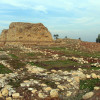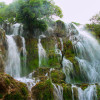
Chahartaq of Niasar Fire Temple
The fire temple of Niasar is a Chahartaq structure with a dome on top. It is located in the margins of Kashan plain on the hillsides of Karkas, on the megalithic lands in the eastern side of Kashan County, 1741 meters higher than sea level. According to historiographies, after killing the nobles of Kashan, Ardeshir Babakan, or Ardashir I, was returning to Isfahan while carrying their heads. On his way, he came across a spring and camped in the place where today is known as Niasar. He later built a city there and named it Niansar. In a certain time it was also known as Niastar.
The structure of the fire temple of Niasar Chahartaq is a cube of limestone and plaster mortar, each side about eleven meters. The plan of this Chahartaq, is only eleven degrees deviated from north, which is speculated to be deliberate because it is seen in almost all the Sassanid fire temples. The high status of the north in Zoroastrian religious also proves this hypothesis.
The dome of Chahartaq of Niasar Fire Temple is ruined, but it is believed that it was a kind of Khaki dome that looks like an eggshell. The dome was reconstructed in 1955 but in the form of Islamic domes that do not resemble ancient domes of Iran.
Some of the archeologists have come to believe that this Chahartaq had some stucco decorations. Today the Ezareh stones (stones attached to lower parts of walls as protection) of the outer façade are viewable, as well as the plaster cover of inside. Pointed barrels of this structure are formed by arrangements of layers of stones. The scientists think that the stones have been excavated from Niasar cave.
There are remaining cairn walls in the site of Niasar Fire Temple. Aside the fire temple itself, three other structures are known to exist in its eastern sides.
The potteries found in fire temple of Niasar are parts of urns and pots in cream, red, with designs that have been carved into or added to them. Glazed potteries in turquoise, green, blue and white has also been found.
Chahartaq of Niasar Fire Temple has been registered as one of the national heritages of Iran. Even though in comparison with Kashan, Niasar has cold weather because of its geographical position, and is considered an ideal tourist destination in summer, the best time to visit is spring and autumn. During May and March, the tourists can enjoy the festival of Damask rose and rose water in Niasar, too.

